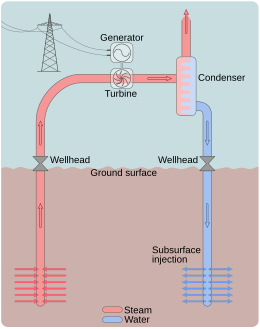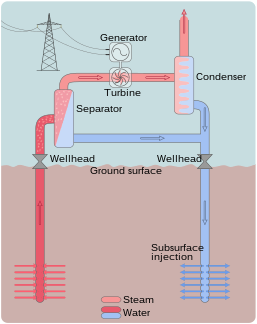地熱能發電
地熱能發電(英語:Geothermal power)是指以地熱能為動力來源,以驅動發電機產生電力。地熱能發電技術主要可分為乾蒸汽(Dry Steam)、閃發蒸汽(Flash Steam),以及雙循環(Binary cycle)三種。目前全球已有29個國家或地區有地熱能發電營運,截至2019年底總裝機容量為15,400 MW。裝置量領先的國家包括美國、印度尼西亞、菲律賓、新西蘭等[1]。
根據地熱能協會(Geothermal Energy Association,簡稱GEA)估計,目前全球地熱能僅利用總潛能6.9%,政府間氣候變化專門委員會估計全球地熱能潛能在35 GW至2 TW之間[2]。地熱能發電被認為是一個可持續發展的可再生能源,因為其提取的熱量僅占地球內部熱能很小的一部分[3]。地熱能發電站的溫室氣體排放量平均約為每千瓦·時45克二氧化碳,不到傳統燃煤電廠排放量的5%[4]。
發展沿革
地熱能發電起源於20世紀初期。1904年7月4日,皮耶羅·吉諾里·孔蒂(義大利語:Piero Ginori Conti)在義大利拉德雷洛測試了全球第一台地熱發電機,成功點亮了四個燈泡[5],之後當地於1911年建立第一座地熱能發電站。1920年代日本別府與美國加州建造地熱能發電實驗機組。1958年,新西蘭懷拉基發電站為第一座使用閃發蒸汽(Flash Steam)技術的地熱能發電站[6]。1960年,太平洋瓦斯與電力公司在美國加州建立地熱能發電站[7]。1967年,蘇聯首次展示雙循環(Binary cycle)地熱能發電站;美國於1981年發展雙循環地熱能發電站。2006年,位於美國阿拉斯加切納溫泉的雙循環地熱能發電站,使用57°C(135°F)的工作流體,創下最低溫度記錄[8]。
發電站類型
乾蒸汽
乾蒸汽(Dry Steam)是最簡單,最古老的設計。這種類型的發電站並不常見,因為地殼中有可直接利用的乾蒸汽之地點不易尋得。使用乾蒸汽之地熱能發電設施最簡單,且效率最高[9]。使用乾蒸汽之地熱能發電直接使用超過150°C的地熱蒸汽來推動渦輪發電機[2],當渦輪旋轉時,它為發電機提供動力,然後產生電力並且輸出[10],使用後的蒸汽被排放到冷凝器。在這裡蒸汽冷卻成水。水冷卻後,經由管道將冷凝後的水導回深井,以便吸收地底的熱能,並再次利用[11]。
閃發蒸汽
閃發蒸汽(Flash Steam)適用於地層中的流體為水汽混合型態,為目前最常見之地熱能發電站類型。此類型發電站需要流體溫度至少180°C,甚至更高。流體在自身壓力下,流經管道至分離器(Separator),在此由於壓力下降而產生閃蒸現象,於此將蒸汽與水分離,並將蒸汽用於推動渦輪發電機。剩餘的水和冷凝的蒸汽都可以注入回到地層中,從而成為可重複利用的可再生能源[12]。
雙循環
雙循環(Binary cycle)並不是直接使用地層中的流體來推動發電機,而是利用較低沸點的工作流體來推動渦輪發電機[8],此種形式的地熱能發電站有逐漸增加的趨勢。工作流體在常溫下為液態,其管路與地熱源管路不相通,兩者經由熱交換器將地層中流體的熱能傳遞至工作流體,使得工作流體轉為氣態,藉以推動渦輪發電機。此形式的流程稱為朗肯循環(Rankine cycle),若是工作流體為有機化合物,則稱為有機朗肯循環(Organic Rankine cycle,簡稱ORC)。這種類型的站的熱效率通常約為10~13%[13],通常機組越大小率越高,目前國內廠商有漢力,國外則有Ormat、Turboden、Orcan Energy、大陸天加收購的Xergy,其中Ormat、Turboden、Xergy主要都是MW級以上廠商,漢力提供的ORC 從10KW ~ 1500KW都有。Orcan Energy 提供50 KW~200KW的模組化ORC。
參見
- 增強型地熱系統
- 地熱供暖
- 乾熱岩熱能
參考資料
- ^ 2020 TO BECOME A MILESTONE YEAR FOR THE GLOBAL GEOTHERMAL ENERGY SECTOR. https://www.geothermal-energy.org/. [2020-07-12]. (原始内容存档于2020-11-15) (英语).
- ^ 2.0 2.1 Fridleifsson, Ingvar B.; Bertani, Ruggero; Huenges, Ernst; Lund, John W.; Ragnarsson, Arni; Rybach, Ladislaus, O. Hohmeyer and T. Trittin , 编, The possible role and contribution of geothermal energy to the mitigation of climate change, Luebeck, Germany: 59–80, 2008-02-11 [2020-07-12], (原始内容存档于2023-02-24)
|conference=被忽略 (帮助) - ^ Rybach, Ladislaus, Geothermal Sustainability (PDF), Geo-Heat Centre Quarterly Bulletin 28 (3) (Klamath Falls, Oregon: Oregon Institute of Technology), September 2007, 28 (3): 2–7 [2020-07-12], ISSN 0276-1084, (原始内容存档 (PDF)于2012-02-17)
- ^ Moomaw, W., P. Burgherr, G. Heath, M. Lenzen, J. Nyboer, A. Verbruggen, 2011: Annex II: Methodology. In IPCC: Special Report on Renewable Energy Sources and Climate Change Mitigation (PDF): 10, [2020-07-14], (原始内容存档 (PDF)于2013-06-27)
- ^ Tiwari, G. N.; Ghosal, M. K., Renewable Energy Resources: Basic Principles and Applications., Alpha Science Int'l Ltd., 2005, ISBN 1-84265-125-0
- ^ IPENZ Engineering Heritage. Ipenz.org.nz. 2013-06-22 [2020-07-14]. (原始内容存档于2013-06-22).
- ^ McLarty, Lynn; Reed, Marshall J., The U.S. Geothermal Industry: Three Decades of Growth (PDF), Energy Sources, Part A: Recovery, Utilization, and Environmental Effects (London: Taylor & Francis), 1992-10, 14 (4): 443–455 [2013-07-29], doi:10.1080/00908319208908739, (原始内容 (PDF)存档于2016-05-16)
- ^ 8.0 8.1 Erkan, K.; Holdmann, G.; Benoit, W.; Blackwell, D., Understanding the Chena Hot Springs, Alaska, geothermal system using temperature and pressure data, Geothermics, 2008, 37 (6): 565–585, ISSN 0375-6505, doi:10.1016/j.geothermics.2008.09.001
- ^ Tabak, John. Solar and Geothermal Energy. New York: Facts On File, Inc. 2009: 97–183. ISBN 978-0-8160-7086-2.
- ^ Geothermal Energy. National Geographic. National Geographic Society. 2012-11-20 [2020-07-12]. (原始内容存档于2020-11-11).
- ^ Gawell, Karl. Economic Costs and Benefits of Geothermal Power (PDF). Geothermal Energy Association. 2014-06 [2020-07-12]. (原始内容存档 (PDF)于2020-07-12).
- ^ Geothermal Energy. National Geographic. [2020-07-13]. (原始内容存档于2021-01-08) (英语).
- ^ Geothermal Basics Overview. Office of Energy Efficiency and Renewable Energy. [2008-10-01]. (原始内容存档于2008-10-04).
| ||||||||||||||||||||||||||||||
Text is available under the CC BY-SA 4.0 license; additional terms may apply.
Images, videos and audio are available under their respective licenses.






